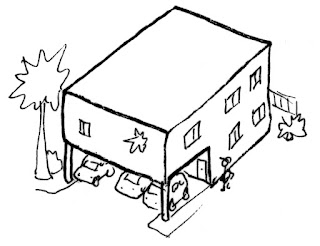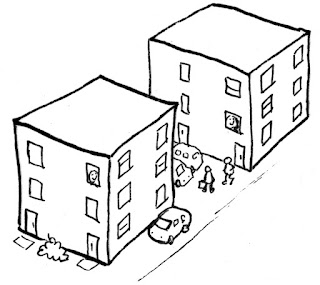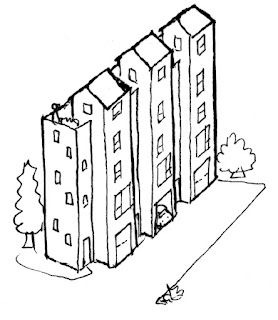Dingbat
Time period: 1950s-1960s
Location: Los Angeles and other cities in the Western US
6+ homes and parking spaces, all on a standard house-sized lot, named after the fanciful decor tacked onto the front.
The dingbat was invented in post-WWII Los Angeles to meet the housing needs of a growing city as well as growing rates of car ownership. The standard 50' wide, 150' deep LA lot had been gridded out for detached houses, but many were zoned for low-rise apartments. Before the dingbat, the most popular types of medium-density housing were bungalow courts - a series of houses around a central walkway, as well as multistory courtyard apartments. In 1934, both types were banned by a new zoning law that required parking: one space per unit.
Developers solved this math problem by turning the front yard into a driveway, leading to a carport that took up the front of the first floor. To maximize space, the second floor extends over the carport, propped up on stilts. This type of structure is a soft story and is dangerous in earthquakes, but can be retrofitted to be safe by reinforcing the stilts with a steel moment frame to make it more rigid.
The cost to build and the income from a dingbat were just the right size to be a "stucco retirement plan".
- Six tenants each pay 1/3 of their income in rent, for a total of 6/3 or 2 incomes
- Half the rent goes to taxes, maintenance, insurance, losses due to vacancy, etc
- Remaining profit is 1 income for the owner to retire on.
With their wide-open fronts and jet age decor of bright colors, starbursts, and names of exotic vacation destinations written in cursive, dingbats were the residential counterpart of Googie-style commercial buildings. It fit the spirit of the time, when Los Angeles was the center of the aerospace industry. Blessed by year-round good weather, Southern California was the perfect place for testing and making airplanes in the early days of aviation when airplanes had open cockpits. During World War 2, the SoCal airplane industry grew to be the biggest in the world, making 2/3 of all airplanes in the United States. Pulling into the carport in a mid-century land yacht with tail fins, a driver could imagine oneself as a pilot bringing an airplane into a hangar.
Dingbats were popular with builders and tenants, but neighbors hated them. Since the entire front of a dingbat lot was driveway, the amount of street parking went down. Dingbat households with more than one car had to park the 2nd car on the street, further worsening the parking situation. In 1958, a new zoning law banned the wide driveways, and in 1964, another law increased parking requirements. In response, developers shifted to building taller buildings with full-floor garages, such as half-basement garage buildings or podium buildings.
No more new dingbats could be built, but thousands had already been built, and they became a part of LA culture. TV and movies introduced them to the rest of the country, with dingbat-dwelling working class heroes contrasted with rich villains in gated mansions. Like the New York City walkup apartment, the LA dingbat is the city's symbol of low cost housing.
Dingbats and Rent Control
While only recently popular among architectural historians, efforts to preserve dingbats have been going on since the 1980s, for a different reason: rent control. Although San Francisco has higher rents, the affordability crisis is worse in Los Angeles since LA rents are almost as high as SF rents, but LA incomes are much lower.
The banning of dingbats, which was followed by further restrictions on housing development, caused the rate of homebuilding to drop even as population kept growing. By the late 1970s, the housing shortage coupled with inflation put a double squeeze on LA tenants. Responding to the crisis, in 1978, Los Angeles passed moratorium on rent increases, which later became today's Rent Stabilization Ordinance.
The RSO, also known as rent control, limited how much landlords could raise an existing tenant's rent each year, based on the rate of inflation. It also included what is known as Just Cause tenant protections, which means that tenants can only be evicted if the landlord has a just cause, such as rent not being paid or intentional property damage by the tenant. As a compromise to avoid discouraging new apartment construction, the RSO did not apply to any new buildings built after October 1, 1978.
As rents for new leases in LA continued to go up faster than inflation, a longtime tenant would be paying a lower rent than a neighbor in an adjacent unit that just moved in. Landlords wanting more profits wanted to get these long-time tenants out. In 1985, the Ellis Act, a state law sponsored by landlords, added another cause to the list of just causes: closing the building for demolition or turning it into condos.
When the Cold War ended in 1989, the US won, but LA lost. Defense contracts were cut back, leading to layoffs of high-paid factory and engineering jobs. Production of airliners in California also came to an end as the US airliner business consolidated down to a single manufacturer, Boeing, which was based in Seattle. The replacement jobs were low paid service and manufacturing jobs.
LA's great weather, while no longer essential for the airplane business, was still important for leisure and tourism. Throw in the glamour of Hollywood, and the city continued to be a magnet for the rich and famous. LA tenants continued to suffer losses, with one of the largest being the 1995 Costa-Hawkins Act. Named after a corporate Democrat and a Republican legislator, Costa-Hawkins put limits on the types of laws cities could pass to limit rent increases.
Among these limits was a rule that cities like LA could not change the cut-off date for when buildings were rent controlled. In a city with little public housing, it meant that the dingbats, stucco boxes, and pre-dingbat buildings were all that LA had for low cost housing. However, since existing apartment zones were the only places the city allowed new apartments to be built, they were also prime targets for demolition.
Tenants fought back. While cities could not stop the demolitions, they could slow them by making it take longer or cost more. One example are laws requiring the landlord pay relocation payments to the tenant when demolishing a unit, as well as penalties for harassing tenants to leave. In 2019, tenant organizing delivered two landmark state laws: the Tenant Protection Act (AB1482) and the Housing Crisis Act (SB330). AB1482 extended some protections to tenants in newer buildings and other buildings not covered by rent control. SB330 required that any demolished rent controlled units be replaced by an equal number of affordable housing units in the new building.
Still, the depth of the LA housing crisis is so large that these laws have not been able to fully solve the problem. 3/4 of all LA tenants spend over 30% of their income on rent. Half of all LA tenants are severely rent burdened - paying over 50% of their income. Homelessness exploded, becoming the worst in the country. Others coped by doubling up with friends or family - LA also has the highest rate of overcrowding in the country. This became deadly during COVID, when overcrowded households did not have enough rooms for people to isolate in when infected.
- - -
In the 2010s, as dingbats turned 50, architects and historians became more interested in the type, as is typical of styles when they turn 50. Coffeetable books of dingbat facades were published and design competitions were held to imagine what the next generation of low-cost housing in Los Angeles might look like.
Developers came up with their own successor to the dingbat: the double duplex. Like the dingbat, it packed about 7,000 square feet of housing plus a few parking spaces on a 7,500 square foot lot. To make room for the now-required front yard, double duplexes were three floors tall. To reduce the number of parking spaces required, instead of having 6+ studios, 1-bedroom, and 2-bedroom units, a double duplex had just 4 units, but each of them had 4 or 5 bedrooms, designed to be rented out separately. Like the dingbat, double duplexes were boxy, cheap, and hated.
Finally, in the 2020s, aided by Yes In My Backyard (YIMBY) activism, the state government forced LA to properly deal with their housing shortage. One of the new state laws, 2018's SB828, required cities to rezone to allow more housing, or face the Builder's Remedy - a situation where a developer could build whatever they want regardless of local zoning, as long as 20% of the homes were reserved for low income residents. Organizations such as Abundant Housing Los Angeles proposed plans and took part in the process to make sure that rezones were realistic and large enough.
Another state law, 2022's AB2097, eliminated all parking requirements within a half mile circle of major transit stops. By now, LA had built a large subway and light rail system, and had high-frequency buses running on other major streets. However, we are unlikely to see a return to bungalow courts, as demand and land values are now much higher than they were in the 1920s. Instead, look to Koreatown, where existing zoning is already higher density, for a hint of what the next generation of LA housing might look like on the standard 50'x150' lot: 6-8 story "5 over 1", "5 over 2", and "5 over 3" small lot podium apartment buildings.
Data
- Density: 35-70 units/acre
- Typical Lot Size: 7,500 square feet (50'x150')
- Typical Zoning: Low Density Multifamily, Restricted Multiple Unit
- Construction Type: V (Wood frame)
- Resident Type: Rental
Where to build
- Suburbs with moderate levels of car dependence, where households have 1-2 cars.
- Single-family sized lots.
Further Reading
History of LA zoning https://la.urbanize.city/post/forbidden-city-how-los-angeles-banned-some-its-most-popular-buildings
Age of buildings in LA https://cityhubla.github.io/LA_Building_Age/#12/34.0267/-118.2621
Research on the history of dingbats https://www.proquest.com/openview/16ba8e498482d9ae8cab1ef18814418e/1.pdf?pq-origsite=gscholar&cbl=18750&diss=y
More research on dingbats: Dingbat 2.0 The Iconic Los Angeles Apartment As Projection of A Metropolis
by Grant, Thurman (EDT)/ Stein, Joshua G. (EDT)/ Betsky, Aaron (CON)/ Bestor, Barbara (CON)/ Fiskin, Judy (PHT) (book)
General article on dingbats https://www.bloomberg.com/news/features/2021-09-24/a-design-history-of-l-a-s-dingbat-apartment-buildings
The economics of dingbats https://letsgola.wordpress.com/2014/12/04/dingbat-renaissance/
Example of Dingbat decor https://ellenbloom.blogspot.com/2016/01/oh-those-fancy-names.html
LA downzoning https://www.lewis.ucla.edu/programs/housing/housing-supply/zoning/
Los Angeles Rent Control ordinance https://housing.lacity.org/residents/rso-overview
History of rent control in LA: https://luskincenter.history.ucla.edu/wp-content/uploads/sites/66/2018/09/People-Are-Simply-Unable-to-Pay-the-Rent.pdf
What the Costa-Hawkins law does, and the impact on renters: https://www.tenantstogether.org/campaigns/repeal-costa-hawkins-rental-housing-act
AB1482 Tenant Protection Act https://www.tenantstogether.org/resources/1482
SB330 Housing Crisis Act replacement unit law https://www.yimbylaw.org/unit-replacement
High rent burdens in LA in the 2010s https://socialinnovation.usc.edu/rent-burden/
Overcrowding in California housing https://data.chhs.ca.gov/dataset/housing-crowding
Overcrowding causing higher spread of COVID https://calmatters.org/projects/california-coronavirus-overcrowded-neighborhoods-homes/
Low Rise Los Angeles Design Competition https://lowrise.la
Abundant Housing Los Angeles work on housing elements https://abundanthousingla.org/wp-content/uploads/2022/11/AHLA-Housing-Element-Accomplishments-Paper-1.pdf
SB828 and other state laws https://ternercenter.berkeley.edu/wp-content/uploads/2023/04/New-Pathways-to-Encourage-Housing-Production-Evaluating-Californias-Recent-Housing-Legislation-April-2023-Final-1.pdf
AB2097 parking reform https://planning.lacity.org/development-services/assembly-bill-2097







Comments
Post a Comment